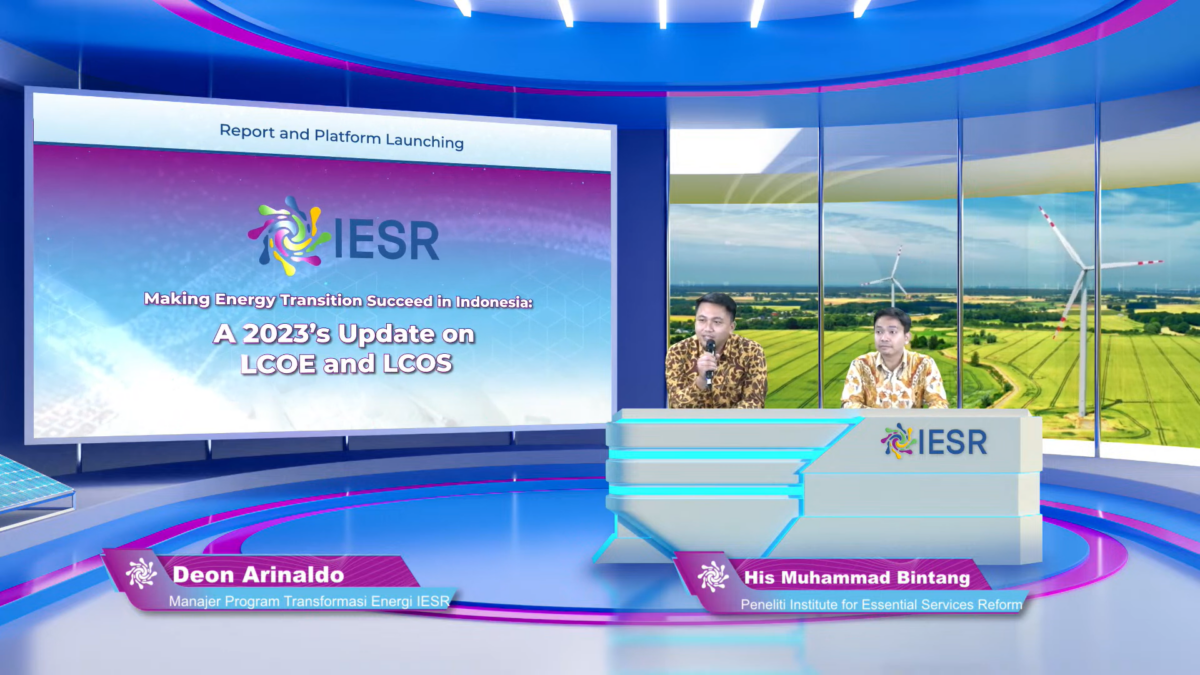Jakarta, 24 March 2023 – The development of various renewable energy generation technologies continues to experience developments which have an impact on the price of the electricity produced. Apart from technology, several types of power plants are also influenced by various factors, including fuel commodity prices, as well as the geopolitical situation.
In opening remarks for the launch of the report and tool for calculating the levelized cost of electricity (LCOE) and levelized cost of storage (LCOS), Fabby Tumiwa, Executive Director of the Institute for Essential Services Reform (IESR) said that there are two contradictory conditions between renewables and fossil generators.
“Almost all renewable energy generators have decreased prices. Solar PV decreased by 90% and wind decreased by around 80%. Until now, the price of fuel or fossil fuels continues to be influenced not only by costs, but also by geopolitical conditions. Renewable energy power plants will not be affected by fuel prices, because they do not use fuel,” he said.
The author of the report “A 2023’s Update on The Levelized Cost of Electricity and Levelized Cost of Storage in Indonesia” His Muhammad Bintang explained similar findings. According to him, in Indonesia, electricity from coal-fired power plants is believed to be cheaper than electricity from renewable energy plants, even though there are many factors that cause this to happen.
“The price of coal electricity is cheap because of the Domestic Market Obligation (DMO) policy. This policy makes the PLTU have a relatively cheap and stable generation cost,” said Bintang.
Bintang added that without the DMO policy, the price of electricity from coal-fired power plants could increase up to three times when global coal prices rise.
Another policy that will affect the cost of energy generation is the implementation of carbon economic values such as carbon caps and carbon taxes. The application of carbon economic value needs to be ensured to be effective by ensuring a competitive carbon quota (cap) or price. Determining the appropriate carbon economic value is expected to reduce the use of fossil energy and encourage the development of renewable energy.
On the same occasion, Mustaba Ari Suryoko, Coordinator of Services and Oversight of Various NRE Businesses, Directorate General of EBTKE, Ministry of Energy and Mineral Resources, explained that changes in the movement of renewable energy prices at the global level actually occurred in Indonesia.
“We identified that the price reduction was relatively related to technology. For example in solar and wind, biomass is related to feedstock, and some are stagnant such as hydro,” Mustaba said.
Mustaba explained, the Ministry of Energy and Mineral Resources is currently drafting regulations equivalent to laws for the development of renewable energy. Previously in Presidential Decree No. 112/2022 is mandated to carry out price evaluations. The existence of LCOE and LCOS calculating devices will assist in carrying out this evaluation, of course by adjusting the assumptions used as parameters.
One of the key actors in the development of renewable energy and the energy transition in general is PLN, which acts as an offtaker of the electricity generated by the generator. The development of technology, which has an impact on the price of electricity, has not escaped PLN’s attention.
As stated by Cita Dewi, EVP of New and Renewable Energy at PT PLN, the trend of decreasing electricity prices from renewable energy plants is included in PLN’s monitoring.
“PLN welcomes this, because we realize that to make the energy transition we need a lot of EBT generators,” said Cita.
Apart from generators, PLN also has the mandate to build a renewable energy ecosystem and ensure that renewable energy development projects in the RUPTL are implemented properly.
Looking deeper into the technology side, the decline in solar energy prices is one of them influenced by the increase in the efficiency of solar modules.
“The increased efficiency of solar modules increases solar energy production without increasing costs. In addition, the development of mechanical technology such as nano cells can also reduce production costs or selling costs. This will significantly reduce the cost of solar modules,” explained Andhika Prastawa, Main Engineering Researcher at BRIN.
Evvy Kartini, founder of the National Battery Research Institute, also reminded about the important role of storage or battery technology in the energy transition ecosystem.
“The cost of this energy transition will depend on the battery. Take the example of an electric vehicle, 45% of the price of an electric vehicle is the price of the battery, so if the battery is cheap the price will go down.”
In addition to technological developments, the regularity of the auction schedule is also an important factor in ensuring the development of renewable energy.
“Regarding the risks of developing PLTS in Indonesia, there are certainly risks at every stage. At the development stage, we expect certainty, like providing information about auction schedule and capacity in one year as is done in other countries,” said Refi Kunaefi, Managing Director of Akuo Energy Indonesia.

